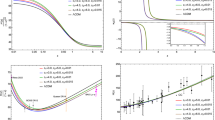Abstract
We try to solve the dark matter problem in the fit between theory and the Hubble diagram of supernovae by allowing for torsion via Einstein–Cartan’s gravity and for anisotropy via the axial Bianchi I metric. Otherwise we are conservative and admit only the cosmological constant and dust. The failure of our model is quantified by the relative amount of dust in our best fit: \(\Omega _{m0}= 27 \pm \ 5 \,\%\) at 1\(\sigma \) level.

Similar content being viewed by others
References
Saunders, P.T.: Observations in some simple cosmological models with shear. Mon. Not. R. Astron. Soc. 142, 213 (1969)
Cea, P.: The ellipsoidal universe in the Planck satellite era. Mon. Not. Roy. Astron. Soc. 441, 1646 (2014). [arXiv:1401.5627 [astro-ph.CO]]
Schücker, T., Tilquin, A., Valent, G.: Bianchi I meets the Hubble diagram. Mon. Not. Roy. Astron. Soc. 444, 2820 (2014). [arXiv:1405.6523 [astro-ph.CO]]
Cartan, É.: Sur les variétés à connexion affine et la théorie de la rélativité généralisée (première partie). Ann. Éc. Norm. Sup. 40, 325 (1923)
Cartan, É.: Sur les variétés à connexion affine et la théorie de la rélativité généralisée (première partie), (première partie, suite). Ann. Éc. Norm. Sup. 41, 1 (1924)
Cartan, É.: Sur les variétés à connexion affine et la théorie de la rélativité généralisée (première partie), (deuxième partie). Ann. Éc. Norm. Sup. 42, 17 (1925)
Hehl, F.W., von der Heyde, P., Kerlick, G.D., Nester, J.M.: General relativity with spin and torsion: foundations and prospects. Rev. Mod. Phys. 48, 393 (1978)
Capozziello, S., Lambiase, G., Stornaiolo, C.: Geometric classification of the torsion tensor in space-time. Ann. Phys. 10, 713 (2001). [arXiv:gr-qc/0101038]
Shapiro, I.L.: Physical aspects of the space-time torsion. Phys. Rep. 357, 113 (2002). [arXiv:hep-th/0103093]
Tilquin, A., Schücker, T.: Torsion, an alternative to dark matter? Gen. Rel. Grav. 43, 2965 (2011). [arXiv:1104.0160 [astro-ph.CO]]
Schücker, T., ZouZou, S.R.: On a weak Gauss law in general relativity and torsion. Class. Quantum Grav. 29, 245009 (2012). [arXiv:1203.5642 [gr-qc]]
Schücker, T., Tilquin, A.: From Hubble diagrams to scale factors. Astron. Astrophys. 447, 413 (2006). [arXiv:astro-ph/0506457]
Amanullah, R., Lidman, C., Rubin, D., Aldering, G., Astier, P., Barbary, K., Burns, M.S., Conley, A., et al.: Spectra and light curves of six type ia supernovae at \(0.511 <~\mathit{z}~< 1.12\) and the Union2 compilation. Astrophys. J. 716, 712 (2010). [arXiv:1004.1711 [astro-ph.CO]]
Betoule, M., et al. [SDSS Collaboration]: Improved cosmological constraints from a joint analysis of the SDSS-II and SNLS supernova samples. Astron. Astrophys. 568, A22 (2014). [arXiv:1401.4064 [astro-ph.CO]]
SIMBAD astronomical database. http://simbad.u-strasbg.fr/simbad/
The ROOT analysis package. http://root.cern.ch/drupal/
Nelder, J., Mead, R.: A simplex method for function minimization. Comput. J. 7(4), 308 (1965)
Rosenblatt, F.: A probabilistic model for information storage and organization in the brain. Cornell Aeronaut. Lab. Psychol. Rev. 65(6), 386 (1958)
TMultiLayerPerceptron: Designing and using multi-layer perceptrons with ROOT. http://cp3.irmp.ucl.ac.be/delaere/MLP/
Acknowledgments
This work has been carried out thanks to the support of the OCEVU Labex (ANR-11-LABX-0060) and the A*MIDEX project (ANR-11-IDEX-0001-02) funded by the “Investissements d’Avenir” French government program managed by the ANR.
Author information
Authors and Affiliations
Corresponding author
Additional information
A. Tilquin and T. Schücker: supported by the OCEVU Labex (ANR-11-LABX-0060) funded by the “Investissements d’Avenir” French government program.
Rights and permissions
About this article
Cite this article
ZouZou, S.R., Tilquin, A. & Schücker, T. Einstein–Cartan, Bianchi I and the Hubble diagram. Gen Relativ Gravit 48, 48 (2016). https://doi.org/10.1007/s10714-016-2050-5
Received:
Accepted:
Published:
DOI: https://doi.org/10.1007/s10714-016-2050-5



